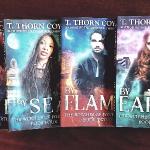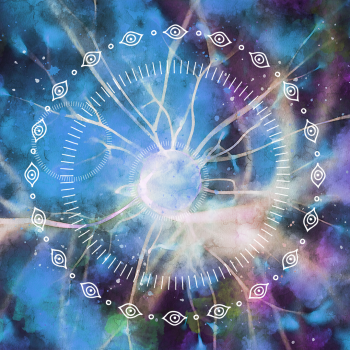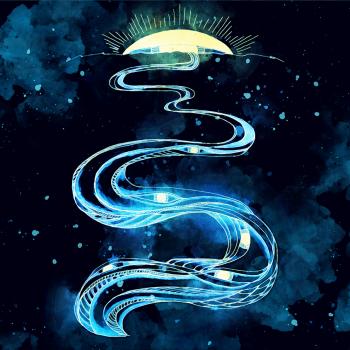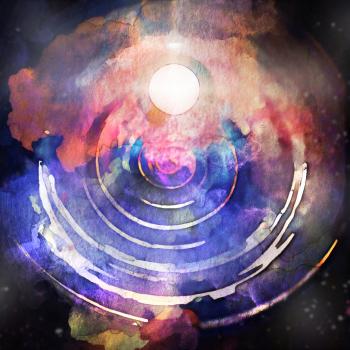As pagans we talk about spirits that we work with like Grandma Eunice, our house spirit, or the dryad that lives in the oak in the park. We also talk about group dynamics like how Sara is bossy, no one wants to do any work for the harvest festival, and the lack of communication about the website, but we talk about them like they’re seperate things. Group dynamics and spiritual beings are not actually different things.
Your group dynamic has a spirit.
I’m such a darn pantheist, aren’t I? But seriously, this is not just something I’ve hypothesized in order to feel better about the fact that I believe that everything in existence has a soul. It’s come up more than once in my priest work. Particularly in the way of “Woah! That’s a messed up egregore you’ve got there!” Because it’s a word I’ve had to define more than once when discussing such things, let’s talk definitions before we dive into what I’m talking about.
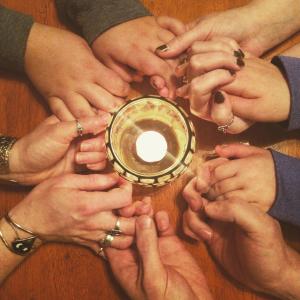
Egregore is a noun that means the spiritual collective of a group mind. It is a created thoughtform that can, if given enough energy and input, become sentient. It’s a word thrown about a lot by chaos magicians who are some of the experts on created spirits. Egregores can develop naturally or be crafted more carefully. A mascot for a team is one way of shaping an egregore. But they also develop more organically like when a group of people start worshipping together and suddenly realize that they know the perfect name for their coven. An egregore can be the narrative and spirit that holds a group together. It can also get out of control, damage group dynamics, and perpetuate toxic environments so it’s important to think about and to know that you can consciously adjust such things, especially if you have skill sets in lore, narrative building, or magic. Marketing and advertising are good cross trainer skill sets for all those things, since as far as I’m concerned marketing and advertising are modern magic.
Disclaimer: if you are in a group where you’re having communication problems, no one will help, or everyone is just cranky and angry at each other, you still have to confront those very real issues with honesty, active listening, and communication. Contacting your group egregore is no substitute for talking to actual people. However, if you’re doing that and you’re still having problems sometimes addressing egregore issues can be super helpful.
I’m going to make a little leap and create a math equation for how you build a group egregore:
Egregore = (Thoughts + Goals + Vision)of each Individual + chosen Symbols + Patron spirits or gods + created group Narrative
Or using just capital letters and getting fancy with it:
E = I * (T+G+V) + S + P + N
Let us examine each part of the equation:
Thoughts, Goals, and Vision of Each Individual:
In Cedarsong grove, my grove, each person brings their own ideas to the group. Those who take leadership or action have more say and therefore more weight in the outcome of the group, but long time quiet members also have a lot of quiet pull. Humans are actually really accurate at picking out group hierarchies. I trust that you can look at your own group and see pecking orders and who tends to be in charge, even if there isn’t a specific leader. Those people who do more tend to get more say as to the group egregore as well.
This is the part that needs to be addressed by actual group dynamics skills. Active listening, negotiation, project management, and a whole host of techniques and skills can be learned by reading leadership books or surviving a committee meeting for a Pagan Pride Day. Note that this is only a quarter of the entire equation. It’s a complicated bit, because each individual has their own ideas and pulls the group in a unique direction. All too often in modern group dynamics this is the only aspect we talk about. I hope by the end of this article you realize there are other tools you can leverage more intentionally.
Chosen Symbols:
This is where it’s a little easier to get intentional. Often at the beginning of a group there’s a great deal of time spent on picking a name along with a symbol that represents that name. Symbols can emerge and develop over time as well. Often, groves and covens choose symbols that are representative of their chosen deities such as a hammer for Thor or a moon for Artemis. Sometimes they are representative of the land around them or people who have come before. For instance, Cedarsong grove was named for the Red Cedar River and the song of our ancestress, Dell Taylor. Sometime groups are named for animals such as Three Cranes Grove, or trees, like Charter Oak Grove, or any number of other concepts, people, places, or objects.
The challenge, once you have chosen a symbol to identify with, is to actually incorporate it into your group’s identity and egregore successfully. The group is never really done with this process. In a heathy group you must allow it to change and morph as the group changes and morphs. I’ll talk more about this when I’ve gotten through describing each part. I would suggest researching lore from your group’s traditions, and combining it with knowledge of your local ecosystem as well as learning about branding and logo design to create potent symbols.
Patron Spirits or Gods:
This one is a surprisingly big deal, and should be allowed to unfold organically. What I mean is that you shouldn’t assume you can pick this. In many ways you need to have a member, or ideally many members who are intuitive and honest enough to share who wants to hang out with you all. This can be challenging for a number of reasons, since it would be an easy way for a couple of people with faux psychic talent to railroad the direction of the group. This is one of the reasons I think it’s important to teach trancework and divination to all members of a group who want to learn it. It helps to give more psychic “data points” so that the messages from the spirit world are clearer.
Don’t force this one. It’s okay to try things out. In Cedarsong we had the hardest time finding deity to work with. We were supposed to stay within the line of “Indo-European” which meant there was a fairly wide range of Euro-Asian cultures we could align ourselves with. However functionally within our religious structures most groups aligned with Celtic, Norse, or occasionally Greek deity. None of those groups resonated with us and it was very challenging.
After a number of years (Yes, it took years. That’s okay.) We developed relationships with Lithuanian Deities, first with Saule, Menulis, and Ausrine and later with many others. It was after a great deal of time and trance work that we eventually settled into having two primary Grove Deities, Gabija the Lithuanian goddess of the Hearth, and Perkunas, the Lithuanian god of Thunder. We also work heavily with Brighid at Imbolc and Lugh at Lammas, and have in other times worked heavily with Ing Freyr and Freyja. At this point much of our symbolism is tied into Gabija and Perkunas, and that story is core to the next section, Creating Group Narrative.
Creating Group Narrative:
Let me tell you a story about how we built our story. Years ago, at my grove retreat there was a great deal of criticism going around. People were unhappy with each other but were trying hard to be polite in public. There was a very uncomfortable energy in the group and a whole lot of hurt feelings, even though everyone was trying very hard. I was not yet a priest in the group, but was the primary ritual creator at the time. Another member, who also became a priest, came to me with her concerns that the group was fracturing and asked if I could come up with a spell or charm for the evening ritual to bring everyone back together.
I started digging through the mystical junk spell components I had brought along and found a sphere of rose quartz that I had been keeping. It felt good in my hands and I sat and pondered what I could do. I thought about what we needed: more unity and goodwill and to remember each of us was a frail human doing our best. I thought about what we had: the symbol of the intuitive whispers of the wind through the trees which is the Cedarsong, the river we called ourselves for and the gods we had been working with. I saw a fire at the center of that rose quartz and felt an echoing fire within myself, my love for my grove and my people. It was that love that I wanted to focus on and so I started the tradition of the Heart of the Grove. That night and each year afterward we charge that stone as the physical representation of our created egregore using the symbol of the Heartfire as Hearthfire. Each of us tends the hearth of our own hearts and the hearth of our grove. It was an intuitive moment and a shift for the grove.
The Senior Druid, the elected administrative leader in our dynamic, is the keeper and tender of the physical Heart of the Grove. There is also a strong astral component that we interact directly with through trancework and ritual. I’m not going to share too much about that process, because it’s meant for our members. But you can create your own narrative about your group. Are you the people who tend the hearthfire? The people who reach for the stars? The people who are always helpful? Looking at mission statement and visioning concepts can help in the process, but eventually you have to leap off of that kind of more formal work into the land of story, myth, and poetry.
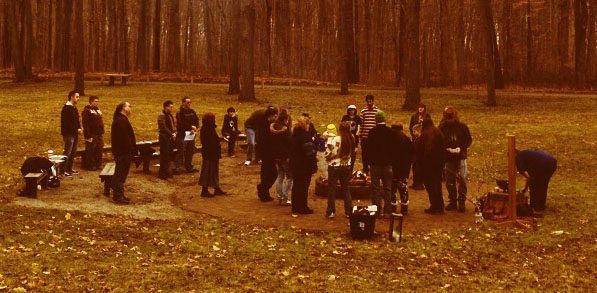
Interacting with your Group Egregore
Otherwise known as: Look Mom! We Made a Thing! Now what do we do with it?
Do a ritual to get it rolling. Build energy in the way that your group does that sort of thing and send it towards your chosen symbols and narrative. Don’t worry if you don’t have guardian spirits or gods yet, but do ask friendly spirits from your tradition to be involved.
Work it into your group’s annual celebration cycle and leadership. We always make sure to bring the physical heart of the grove to every high day, but especially at Lammas, which is when we elect our new officers. One of my jobs as priest is to oversee that transition, ritually, magically, and functionally. I make sure the new senior druid knows what they are supposed to do in terms of reports and tech as well as transferring the energetic power of the heart to the next person. The past Senior Druid is the one who hands the new Senior Druid the heart, while I speak about service and remind everyone that without all of our hearts, the heart of the grove will fail.
Lead guided trance work. Interact in a spiritual way with your narrative, patrons, and chosen symbols. Make sure to give plenty of time for each individual to experience these things. Allow people to share their experiences afterwards and particularly note the commonalities between visions. Each person will view spiritual realities in their own unique way. Part of spirit work is honing one’s ability to see past your mental interpretation to spirits beyond. I’m constantly amazed by how powerful actually listening to each other and comparing notes can be in building group narrative.
Ideally, I would suggest using one or two potent symbols to anchor the experience. In my group we have a pathway guarded by Perkunas and guided by Gabija. Other groups connect with different symbols. Three Cranes Grove connects with Garanus the crane, who guides them in trance and magic. Other groups use other symbols. Recently I was consulted when a group’s symbols and dynamic had gotten a bit off, which was what sparked this post.
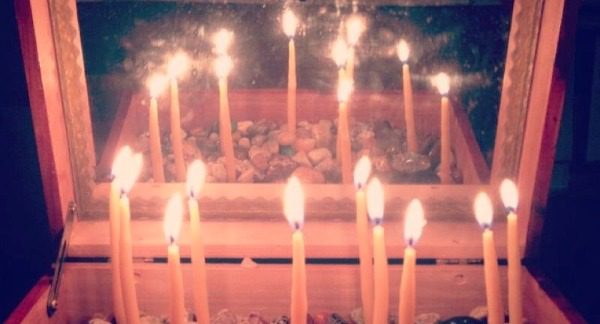
When Egregores Go Awry
Group dynamics and egregores are deeply connected, so when one goes bad, so does the other. This is similar to how the spirits of the land get disturbed and angry when species die or rivers become toxic. That’s why I suggest addressing both the spiritual and the psychological sides of the issue. I’ve certainly experienced bad group dynamics many times, since I was a baby pagan many years ago. Certainly back then I didn’t have the foggiest notion of what an egregore was or how it might function, but for the past half a dozen years or so I’ve been thinking hard about and dealing with such things.
Most recently, I was approached about a group that was having trouble transitioning their leadership. One person had been the leader for a long time and needed to step back, but others were having a hard time stepping up into leadership roles. This group had done the work to choose a symbol that went with the name of their group. It was a tree. It was an actual living tree, that was in their area. Recently it had been cut down and now their group was in something of a crisis.
They were planning on looking for a new tree to dedicate as their special group tree while trying to deal separately with their leadership issues. I saw the whole thing as a combined dynamic of too much focus on the individual in their symbology. By choosing one single tree, they set themselves up for the eventual death of that tree which had been a huge symbolic hit for the group. To quote from The Highlander, they also set up the unconscious suggestion that “There can be only one!” While that makes for fun tv, it’s less useful when you’re trying to survive as a small volunteer driven religious group.
I suggested that the group focus on revamping their group symbol. Instead of focusing on one specific tree, they could choose a species of tree that is significant to the area. I also suggested that the whole group could go plant some trees to honor the tree that had passed. By having everyone participate in planting a group of trees they could shift their symbol to a narrative that was less “tree” and more “grove” which echoes and resonates with the shared leadership they were hoping to cultivate.
Advertising textbooks for both graphic design and copy writing are well worth studying for idea on how to cultivate a cohesive group narrative. The trick is that instead of doing it to sell more stuff you’re using those skills to create the kind of group mind you are consciously choosing to develop.
I have found that it is easier to shift the egregore of a group that is unsettled or young. Eventually habits are built, both in group dynamics and group energetics and the egregore tends to settle. I have found that in particular once it gains sentience, it’s less about directly changing the egregore and more about communicating with it and teaching it things or negotiation. It’s almost as if the egregore itself becomes one of the individuals in the group with it’s own thoughts, goals, and vision. The upside of this is that if your leadership fails or people as individuals are struggling, the group egregore can really hold things together. The downside is that if your group has toxic behaviors or needs to do some serious shadow work all that comes out loud and clear in the personality of the group egregore. It is literally created from those things. Just like humans, spirits are what they eat. When they’re fed a diet of passive aggressive behaviors, gaslighting, or cruelty that is part of what they are even if there are also many good things about a group. Egregores hold up a very clear and honest mirror to the truth of a community. The thing I have seen again and again is that ignoring your egregore or trying to keep it from changing are both very bad ideas.
If you’ve actually made it this far I’m totally impressed, this has turned into a very long post. While there’s a part of me that wants to put out a warning to be careful, to make sure you have the skills you need to interact with such things, I won’t. Even though I’ve seen egregores that can be dangerous, and I’ve seen what happens when they get buried in the the metaphorical back woods, I know that people are going to keep making groups and communities. I hope that this writing is a guidepost or at least a comparison point for those of you doing the hard, brutal, thrilling, crucial work of building pagan community. Good luck.
It takes a lot of work to go from a random phone call to a researched 2000 word blog article with edited photos and grammar-y things. Please consider becoming a Patreon to keep my priestwork and spiritwork posts here and helpful. Thank you.

